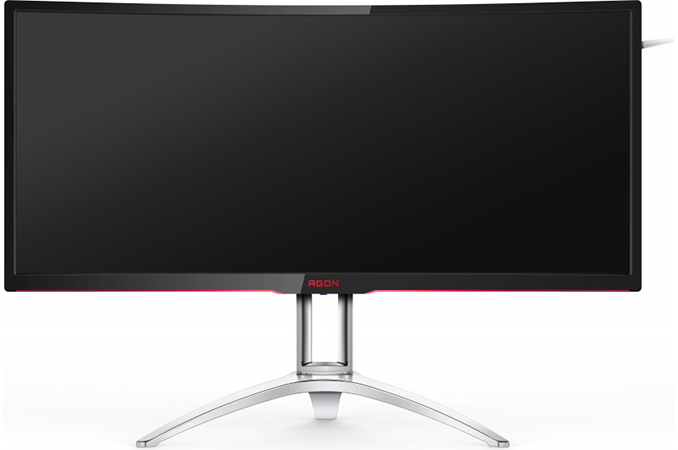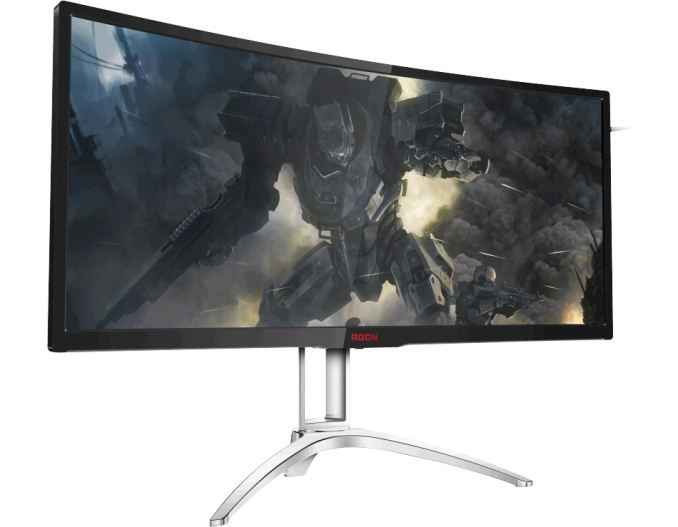AOC Announces the AGON AG352UCG 21:9 Curved Display: 35", 3440×1440, 100Hz with G-Sync
by Anton Shilov on January 26, 2017 4:00 PM EST- Posted in
- Monitors
- Displays
- AOC
- G-Sync
- Curved Display
- AGON
- UWQHD
- AGON AG352UCG

Last week AOC introduced its new high-end curved gaming display, the AGON AG352UCG. The new 35” monitor boasts a considerably higher resolution than AOC’s other large curved gaming display. The 3440×1440 resolution, size, curvature, a 100 Hz refresh rate and G-Sync support make the AG352UCG one of four curved displays with such combination of features. The other AGON AG352QCX 21:9 panel is a 2560×1080 resolution, but with a 200 Hz refresh rate.
The AOC AGON AG352UCG uses a 35” MVA panel with a 3440×1440 resolution, a 21:9 aspect ratio and a native 100 Hz refresh rate (which means that actual panel response times are perfectly aligned with its high refresh rate). We presume the panel is made by AUO (AU Optronics), which reportedly started volume production of such panels in September, 2016. General specifications of the monitor are similar to many other gaming displays: 300 nits brightness, 2000:1 contrast ratio, 178°/178° viewing angles, 16.7 million colors, a 4 ms response time (grey-to-grey) and so on.
When it comes to connectivity, the AGON AG352UCG has a DisplayPort input and an HDMI input. To take advantage of NVIDIA’s G-Sync as well as the high refresh rate, the DP connector has to be used. The monitor is also equipped with a dual-port USB 3.0 Type-A hub and two integrated speakers.
| AOC's AGON Curved UWQHD Display with a 100 Hz Refresh Rate | |
| AGON AG352UCG | |
| Panel | 35" MVA |
| Native Resolution | 3440 × 1440 |
| Refresh Rate Range | 30-100 Hz (DP) NVIDIA G-Sync |
| Response Time | 4 ms |
| Brightness | 300 cd/m² |
| Contrast | 2000:1 |
| Viewing Angles | 178°/178° horizontal/vertical |
| Curvature | 2000R |
| Pixel Pitch | 0.23 mm |
| Inputs | 1 × DP 1 × HDMI 1.4 |
| USB Hub | 2-port USB 3.0 hub, one port supports fast charging |
| Audio | 2 W × 2 audio in/out ports |
| Power Consumption | Up to 70 W |
As for visual aesthetics, the curved AOC AGON has a rather aggressive yet minimalistic design that emphasizes its gaming nature through a combination of sharp lines and colors. To add further atmosphere, the AG352UCG has six large LEDs with adjustable colors (red, green, blue) located on the back and on the bottom edge of the display.
The key selling point of the AGON AG352UCG is the combination of its features: the resolution (3440×1440), size (35”), curvature (2000R), a native 100 Hz refresh rate and using NVIDIA’s G-Sync variable refresh tech make up for a very interesting gaming display. At present, only three monitors can offer a similar set of technologies: the ASUS ROG Swift PG348Q, the Acer Predator X34 (this one uses an IPS panel with 60 Hz, but it is overclockable to 100 Hz) as well as the upcoming HP Omen X 35”. By launching the AGON AG352UCG, AOC contends for the highest end of the gaming monitor market and that is clearly an important milestone for the company.
AOC has not formally announced the AGON AG352UCG in the U.S. yet, so we do not know its ETA and MSRP. Meanwhile, Hexus reports that the display will land in the U.K. this March for the price of £799 (that's including 20% sales tax). Therefore expect the AG352UCG to cost around $1000 in the U.S. when it becomes available this spring. Considering the combination of its features (size, resolution, curvature, G-Sync support) and only three direct competitors that retail for $1100-$1300 today, it looks like AOC’s AG352UCG might be priced rather competitively.
Related Reading:
- AOC Launches the AG352QCX: 35-Inch 200 Hz 2560×1080 Curved Display with Adaptive-Sync
- AOC P2779VC: 27” PLS Display with Qi Wireless Charging Base for $199
- Philips BDM4037UW Goes on Sale: 40 Inch 4K Curved Display for $800
- ASUS Announces Designo Curve MX38VQ: 37.5 Inch Curved Display with Qi Charging
- HP Announces Omen X 35-Inch Curved Display for Gamers
Source: AOC


















10 Comments
View All Comments
ant6n - Thursday, January 26, 2017 - link
What's the minimum refresh rate? Does the G-Sync work will with games running, in fps ranges of 20-60fps.Communism - Friday, January 27, 2017 - link
Unlike "Freesync", G-Sync doesn't actually have a minimum refresh rate, it does the trickery of using double or triple or higher of the refresh rate when it goes too low.Communism - Friday, January 27, 2017 - link
It's one of the many things that having the onboard DRAM for it's FGPA allows it to do that "Freesync" cannot.Communism - Friday, January 27, 2017 - link
FPGA*, Curse you lack of edit ability.wolrah - Friday, January 27, 2017 - link
Freesync now does the same basic thing at the GPU end if the monitor has sufficient adaptive sync range. The maximum Freesync refresh rate must be at least 2.5x the minimum rate for it to work. This does definitely restrict the number of monitors it works with, but the feature is there.http://www.amd.com/Documents/freesync-lfc.pdf
At this point a top-end Freesync implementation is as good as G-Sync as far as I'm aware, but Freesync allows much simpler and crappier implementations as well.
Communism - Saturday, January 28, 2017 - link
afaik Freesync still doesn't do dynamic frame rate overdrive (As in adapting overdrive parameters to every single transition type between frame rates).Which happens to be another feature that requires the G-Sync FPGA with lookaside DRAM cache.
Communism - Saturday, January 28, 2017 - link
And there's no way that AMD's "Low Framerate Compensation" doesn't have a latency/synchronization penalty, as you are limited to the transfer rate of the cable/protocol, and thus have to either speculatively send the "compensation" frame at a speculative frame time, and thus risk missing the frame window of the next frame, or you have to wait a frame, and ad a 1 frame latency to the whole thing. While G-Sync only has to send a couple bits of data to indicate that the frame hasn't changed yet if the frame rate is under the panel physical limits, which is essentially instantaneous.